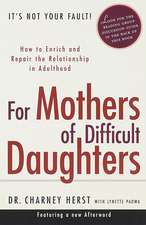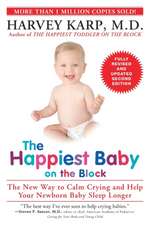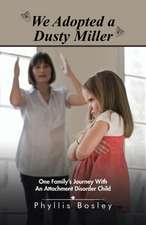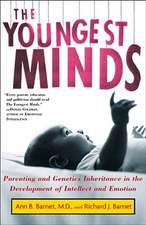Simplicity Parenting: Using the Extraordinary Power of Less to Raise Calmer, Happier, and More Secure Kids
Autor Kim John Payne Cu Lisa M. Rossen Limba Engleză Paperback – 31 iul 2010
• Streamline your home environment. Reduce the amount of toys, books, and clutter—as well as the lights, sounds, and general sensory overload.
• Establish rhythms and rituals. Discover ways to ease daily tensions, create battle-free mealtimes and bedtimes, and tell if your child is overwhelmed.
• Schedule a break in the schedule. Establish intervals of calm and connection in your child’s daily torrent of constant doing.
• Scale back on media and parental involvement. Manage your children’s “screen time” to limit the endless deluge of information and stimulation.
A manifesto for protecting the grace of childhood, Simplicity Parenting is an eloquent guide to bringing new rhythms to bear on the lifelong art of raising children.
| Toate formatele și edițiile | Preț | Express |
|---|---|---|
| Paperback (2) | 108.00 lei 22-36 zile | +18.20 lei 6-12 zile |
| BALLANTINE BOOKS – 31 iul 2010 | 108.00 lei 22-36 zile | +18.20 lei 6-12 zile |
| Hawthorn Press – 24 mai 2019 | 111.20 lei 22-36 zile | +27.10 lei 6-12 zile |
Preț: 108.00 lei
Nou
Puncte Express: 162
Preț estimativ în valută:
20.67€ • 22.46$ • 17.38£
20.67€ • 22.46$ • 17.38£
Carte disponibilă
Livrare economică 31 martie-14 aprilie
Livrare express 15-21 martie pentru 28.19 lei
Preluare comenzi: 021 569.72.76
Specificații
ISBN-13: 9780345507983
ISBN-10: 0345507983
Pagini: 235
Dimensiuni: 135 x 203 x 14 mm
Greutate: 0.3 kg
Editura: BALLANTINE BOOKS
Colecția Ballantine Books
ISBN-10: 0345507983
Pagini: 235
Dimensiuni: 135 x 203 x 14 mm
Greutate: 0.3 kg
Editura: BALLANTINE BOOKS
Colecția Ballantine Books
Notă biografică
A consultant and trainer to more than sixty U.S. independent and public schools, Kim John Payne, M.Ed., has been a school counselor for eighteen years and a private family counselor-therapist for fifteen. Payne has worked extensively with the North American and U.K. Waldorf movements. He is currently project director of the Waldorf Collaborative Counseling Program at Antioch University New England, the director of a large research program on a drug-free approach to attention priority issues disorders, and a Partner of the Alliance for Childhood in Washington, D.C. He lives with his wife and two children in Harlemville, New York.
Lisa M. Ross has been involved with books for more than twenty years, as an editor and literary agent, and now exclusively as a writer. She lives with her husband and two children in Stuyvesant, New York.
From the Hardcover edition.
Lisa M. Ross has been involved with books for more than twenty years, as an editor and literary agent, and now exclusively as a writer. She lives with her husband and two children in Stuyvesant, New York.
From the Hardcover edition.
Extras
Chapter One
Why Simplify?
We are facing an enormous problem in our lives today. It’s so big we can hardly see it, and it’s right in front of our face, all day, every day. We’re all living too big lives, crammed from top to toe with activities, urgencies, and obligations that seem absolute. There’s no time to take a breath, no time to look for the source of the problem.”
—Sarah Susanka, The Not So Big Life
James was about eight years old, and entering third grade, when I met his parents. Lovely and very bright people, James’s mother was a professor and his father was involved in city government. They were worried about their son having trouble sleeping at night, and his complaints of stomachaches. An eight-year-old boy is fairly well designed to be a picky eater, but James’s pickiness was getting extreme. His stomachaches came and went, but they didn’t seem food related.
Both parents spoke proudly of how confidently James could speak with adults, but acknowledged that he had trouble connecting with his peers. He avoided things that he felt might be dangerous, and had only very recently learned to ride a bike. “And don’t forget the driving thing,” his mother mentioned. James’s father explained that whenever they drove someplace, James would be the self-appointed policeman in the backseat, letting them know when they were even one or two miles above the speed limit, scanning the road ahead for concerns of any kind. The term “backseat driver” didn’t come close to describing his behavior; you can well imagine how relaxing these road trips were.
As I got to know the family, I noticed how much their daily lives were colored by world issues. Both parents were avid news followers. The television was often on and tuned to CNN, whether they were directly focused on it or not. Politically and intellectually oriented, they would discuss issues at great length, particularly environmental concerns. From an early age, James had been listening to these conversations. His parents were proud of his knowledge. They felt that they were raising a little activist, a “citizen of the world,” who would grow up informed and concerned.
James’s understanding of global warming seemed to rival Al Gore’s. That much was apparent. James was also, clearly, becoming a very anxious little fellow. His parents and I worked together on a simplification regime. We made some changes in the home environment and greatly increased the sense of rhythm and predictability in their daily life patterns. But our primary focus was on cutting back James’s involvement in his parents’ intellectual lives, and his access to information.
How much information was pouring into the house and into James’s awareness? Instead of three computers in the house, his parents decided to keep one, in the den off the master bedroom. After much discussion, they actually removed both televisions from the home. They felt that this might be harder on them than it would be on James, and they wanted to test their theory. If there were to be sacrifices, they wanted to bear their share of them. They also realized that the TVs had become mainly sources of background noise in their home. Would they be missed or not? Game Boys and Xboxes were also removed, minimizing the number of screens throughout the house.
I was most impressed, however, by the commitment they made to change some very ingrained habits. Quite bravely, I thought, they aimed to keep their discussion of politics, their jobs, and their concerns to a time after James went to bed. This was hard to do at first, and they had to remind each other frequently to refrain from talking about these things while James was still awake. But the change became second nature. The quality of their nightly talks intensified, and both parents came to really appreciate this time together because it was exclusively theirs.
James’s parents noticed changes in him within the first couple of weeks. His level of anxiety went down, and his sleep improved. He started coming up with ideas for projects, and things to do that wouldn’t have interested him previously. It was spring, and the weather was outstanding. Was that it? his parents wondered. At first they weren’t sure, but the trend continued. He was definitely mucking about more, getting involved in building things, catching lizards, digging holes. Within about three or four weeks’ time, James’s teacher also reported changes in him. As his play life expanded, his pickiness about food waned. He started interacting with some of the kids in the neighborhood, particularly one with whom a friendship blossomed. I’ve stayed in contact with this family, and the friend James made when he was going on nine has remained a lifelong buddy. The boys are in their early twenties now, still close and very supportive of each other.
Was all of this directly attributable to the changes James’s family made? Was it the lack of TV? Less talk of global warming? Can we point to any one thing that made the real difference? My answer to that would be no, and yes. I don’t think there was any one thing, any magic bullet that obliterated James’s nervousness and controlling behaviors. But the steps taken to protect James’s childhood definitely had an effect on him and his parents, an effect greater than the sum of their parts. James’s family environment was altered; both the landscape and the emotional climate of their daily life together changed. His parents brought a new awareness to their parenting, and that continued to serve them. It became the new measure of what did or didn’t make sense in their lives. They no longer felt that James had to know everything they knew, or care about everything that concerned them. In acknowledging and protecting that difference, they gave James the freedom to be more deeply and happily his own age.
When you simplify a child’s “world,” you prepare the way for positive change and growth. This preparatory work is especially important now because our world is characterized by too much stuff. We are building our daily lives, and our families, on the four pillars of too much: too much stuff, too many choices, too much information, and too much speed. With this level of busyness, distractions, time pressure, and clutter (mental and physical), children are robbed of the time and ease they need to explore their worlds and their emerging selves. And since the pressures of “too much” are so universal, we are “adjusting” at a commensurately fast pace. The weirdness of “too much” begins to seem normal. If the water we are swimming in continues to heat up, and we simply adjust as it heats, how will we know to hop out before we boil?
I sincerely believe that our instinct to protect our children will be what motivates us to change. Our impetus out of the proverbial pot will be our desire to protect their childhoods. Even as our own inner voices are silenced by the urgencies and obligations of so much stuff, our instincts as parents still give us pause. We stop short— occasionally or often, depending on how sped up our lives have become— and wonder how this pace is affecting them. Inner alarms are sounded when we confront the huge disconnect between how we believe childhood should be, and how it has become.
Such a moment happened to Canadian journalist Carl Honoré, and was the inspiration for his 2006 book In Praise of Slowness. An admitted “speedaholic” himself, Honoré got the idea for his book in just such a moment of great parental alarm. In an airport bookstore while traveling, Honoré saw a series of books called One Minute Bedtime Stories. His first impulse was to buy the whole series and have it shipped, immediately, to his house. In that momentary flash he was remembering the many times when he had been reading to his two-year- old son (“Read it again, Daddy!”) while thinking about unanswered emails and other things he needed to do. The notion of a one-minute story seemed perfect; wouldn’t a few of those each night do the trick? But fortunately, he had a follow-up feeling just as quickly, a sense of alarm and disgust that he—as with so many of us—had reached this point in our mad rush through life. What was this saying, and doing, to our kids?
The Insight
We all have these moments of alarm, don’t we? I know that I do. We’re confronted with the often simple requests of these small beings (whom we love immeasurably), and yet their pleas seem to be coming from a galaxy far away, from the planet “slow.” The two- or three-year-old asking for the same story to be read again and again becomes an eight- year-old who wants to tell you the plot of a movie in such remarkable detail that the retelling will surely take longer than the movie itself. You’ve figured out a complicated car-pool schedule that requires split-second timing, but saves you a roundtrip or two per week. The whole enterprise grinds to a halt each morning around two laces that will not be tied, or one head of hair that cannot be brushed, or one backpack that is always—but always—missing something.
The genesis for this book came with a professional sense of alarm, though my insight evolved more slowly than Honoré’s bookstore revelation. I’m sorry to say it took me well over a decade to fully realize what I had been sensing for a long time. In my late twenties, I completed my training with social services in my home country of Australia, and I volunteered to work with children in Asia at two refugee camps, one in Jakarta, and one in Cambodia, along the Thai- Cambodian border.
In Jakarta the camps were very large, populated by several hundred thousand people who had been dispossessed by political instability. The camps operated like little fiefdoms, with feudal lords and gangs who would “rule” through nasty means, gathering loyalties with promises of protection from other such thug “lords.” It was a large, squalid shantytown—or city, really—with shelters made of cardboard and bits of tin or plastic, whatever could be found. Everyone would walk on planks that were laid on the ground, keeping them only slightly above the effluent that would overflow from drainage ditches and open sewers.
Most of the children I lived among and worked with had never known a different home or life apart from the camp. Their lives were characterized by discomfort, illness, fear, and danger. There was little safety or leisure for these children; survival was a family enterprise. As a people and as individuals they had suffered great losses. And sadly, the children were very clearly diagnosable with post-traumatic stress disorder. They were jumpy, nervous, and hypervigilant, wary of anything novel or new. Many had adopted elaborate little rituals around everyday tasks, such as very specific, complicated ways of navigating the maze of the camp, which they imagined would somehow keep them safe. They were distrustful of new relationships, whether with adults or their own peers, and quite a few had hair-trigger tempers.
After leaving Asia I moved to England, where I completed training as a Waldorf teacher. For years and years I worked in school settings and in private practice as a counselor, seeing kids and making diagnoses: ADD, ADHD, OCD, ODD. It came to seem like some sort of a macabre “waltz of the Ds”—an all-too-common dance these days; this fine carving up of our children.
In the early 1990s I was working in a school, and had a private practice west of London. The children I worked with came from a variety of backgrounds, some British, some immigrant, from lower- middle-class to fairly affluent households. Some of the children I saw professionally were overcontrolling in their behavior toward their parents, their environment, and even their play with other children. Sleep and food were common areas of control; they might stop eating all but one or two foods, or not go to sleep until late into the night. Their anger was easily triggered, very often explosive, and parents would be at a loss to explain the reasons for their outbursts. I was also seeing a lot of nervousness in these children. They would startle easily, and have difficulty shaking it off, or relaxing again. They were mistrustful of new situations, whether new material at school, new people in their lives, or any changes in plans or in their regular patterns of activity. I remember one boy who absolutely refused to go on vacation with his parents. He had never been to the beach before, and the prospect seemed to terrify him.
What finally dawned on me was that the treatment plans I was developing for this group of children were identical to those that I had helped develop in Asia. When I looked at my work objectively, I could see no difference between my methods and goals with these children and those I had while treating the children in Jakarta. What I was at last able to grasp was pretty remarkable. I doubted it for as long as I could, until I was certain: These children, these very typical children from an affluent country of the Western world, were showing the signs and symptoms of post-traumatic stress disorder.
I had been trained to associate PTSD with very large wartime events, with life-changing traumas that leave their victims shaken in no small measure. My work over the last twenty years has taken me to many war-torn areas: Africa, Israel, and Northern Ireland, as well as Russia and Hungary during and just after perestroika. I didn’t expect to find “war-torn” children in this relatively affluent area in England, but sure enough, that’s what I was finding. What struck me first were the similarities in the problematic behaviors adopted by these seemingly disparate groups of children. After so many instances of clinical déjà vu, I couldn’t ignore my instincts. Certain of the symptoms and behaviors, I was becoming more and more convinced of the cause. And as I looked more closely at their lives, I realized that for both groups the sanctity of childhood had been breached. Adult life was flooding in unchecked. Privy to their parents’ fears, drives, ambitions, and the very fast pace of their lives, the children were busy trying to construct their own boundaries, their own level of safety in behaviors that weren’t ultimately helpful. These children were suffering from a different kind of war: the undeclared war on childhood.
If you looked at the lives of these kids in England, searching for a signature traumatic event, you wouldn’t find it. You might expect to see early childhood losses that would cause them to react with such nervousness and distrust, such lack of resiliency and hypervigilance. What I came to realize, however, was that there were enough of the little stresses, a consistent baseline of stress and insecurity, to add up. These little stresses accrue to the point that it makes psychological “sense” for kids to acquire and adopt compensatory behaviors.
From the Hardcover edition.
Why Simplify?
We are facing an enormous problem in our lives today. It’s so big we can hardly see it, and it’s right in front of our face, all day, every day. We’re all living too big lives, crammed from top to toe with activities, urgencies, and obligations that seem absolute. There’s no time to take a breath, no time to look for the source of the problem.”
—Sarah Susanka, The Not So Big Life
James was about eight years old, and entering third grade, when I met his parents. Lovely and very bright people, James’s mother was a professor and his father was involved in city government. They were worried about their son having trouble sleeping at night, and his complaints of stomachaches. An eight-year-old boy is fairly well designed to be a picky eater, but James’s pickiness was getting extreme. His stomachaches came and went, but they didn’t seem food related.
Both parents spoke proudly of how confidently James could speak with adults, but acknowledged that he had trouble connecting with his peers. He avoided things that he felt might be dangerous, and had only very recently learned to ride a bike. “And don’t forget the driving thing,” his mother mentioned. James’s father explained that whenever they drove someplace, James would be the self-appointed policeman in the backseat, letting them know when they were even one or two miles above the speed limit, scanning the road ahead for concerns of any kind. The term “backseat driver” didn’t come close to describing his behavior; you can well imagine how relaxing these road trips were.
As I got to know the family, I noticed how much their daily lives were colored by world issues. Both parents were avid news followers. The television was often on and tuned to CNN, whether they were directly focused on it or not. Politically and intellectually oriented, they would discuss issues at great length, particularly environmental concerns. From an early age, James had been listening to these conversations. His parents were proud of his knowledge. They felt that they were raising a little activist, a “citizen of the world,” who would grow up informed and concerned.
James’s understanding of global warming seemed to rival Al Gore’s. That much was apparent. James was also, clearly, becoming a very anxious little fellow. His parents and I worked together on a simplification regime. We made some changes in the home environment and greatly increased the sense of rhythm and predictability in their daily life patterns. But our primary focus was on cutting back James’s involvement in his parents’ intellectual lives, and his access to information.
How much information was pouring into the house and into James’s awareness? Instead of three computers in the house, his parents decided to keep one, in the den off the master bedroom. After much discussion, they actually removed both televisions from the home. They felt that this might be harder on them than it would be on James, and they wanted to test their theory. If there were to be sacrifices, they wanted to bear their share of them. They also realized that the TVs had become mainly sources of background noise in their home. Would they be missed or not? Game Boys and Xboxes were also removed, minimizing the number of screens throughout the house.
I was most impressed, however, by the commitment they made to change some very ingrained habits. Quite bravely, I thought, they aimed to keep their discussion of politics, their jobs, and their concerns to a time after James went to bed. This was hard to do at first, and they had to remind each other frequently to refrain from talking about these things while James was still awake. But the change became second nature. The quality of their nightly talks intensified, and both parents came to really appreciate this time together because it was exclusively theirs.
James’s parents noticed changes in him within the first couple of weeks. His level of anxiety went down, and his sleep improved. He started coming up with ideas for projects, and things to do that wouldn’t have interested him previously. It was spring, and the weather was outstanding. Was that it? his parents wondered. At first they weren’t sure, but the trend continued. He was definitely mucking about more, getting involved in building things, catching lizards, digging holes. Within about three or four weeks’ time, James’s teacher also reported changes in him. As his play life expanded, his pickiness about food waned. He started interacting with some of the kids in the neighborhood, particularly one with whom a friendship blossomed. I’ve stayed in contact with this family, and the friend James made when he was going on nine has remained a lifelong buddy. The boys are in their early twenties now, still close and very supportive of each other.
Was all of this directly attributable to the changes James’s family made? Was it the lack of TV? Less talk of global warming? Can we point to any one thing that made the real difference? My answer to that would be no, and yes. I don’t think there was any one thing, any magic bullet that obliterated James’s nervousness and controlling behaviors. But the steps taken to protect James’s childhood definitely had an effect on him and his parents, an effect greater than the sum of their parts. James’s family environment was altered; both the landscape and the emotional climate of their daily life together changed. His parents brought a new awareness to their parenting, and that continued to serve them. It became the new measure of what did or didn’t make sense in their lives. They no longer felt that James had to know everything they knew, or care about everything that concerned them. In acknowledging and protecting that difference, they gave James the freedom to be more deeply and happily his own age.
When you simplify a child’s “world,” you prepare the way for positive change and growth. This preparatory work is especially important now because our world is characterized by too much stuff. We are building our daily lives, and our families, on the four pillars of too much: too much stuff, too many choices, too much information, and too much speed. With this level of busyness, distractions, time pressure, and clutter (mental and physical), children are robbed of the time and ease they need to explore their worlds and their emerging selves. And since the pressures of “too much” are so universal, we are “adjusting” at a commensurately fast pace. The weirdness of “too much” begins to seem normal. If the water we are swimming in continues to heat up, and we simply adjust as it heats, how will we know to hop out before we boil?
I sincerely believe that our instinct to protect our children will be what motivates us to change. Our impetus out of the proverbial pot will be our desire to protect their childhoods. Even as our own inner voices are silenced by the urgencies and obligations of so much stuff, our instincts as parents still give us pause. We stop short— occasionally or often, depending on how sped up our lives have become— and wonder how this pace is affecting them. Inner alarms are sounded when we confront the huge disconnect between how we believe childhood should be, and how it has become.
Such a moment happened to Canadian journalist Carl Honoré, and was the inspiration for his 2006 book In Praise of Slowness. An admitted “speedaholic” himself, Honoré got the idea for his book in just such a moment of great parental alarm. In an airport bookstore while traveling, Honoré saw a series of books called One Minute Bedtime Stories. His first impulse was to buy the whole series and have it shipped, immediately, to his house. In that momentary flash he was remembering the many times when he had been reading to his two-year- old son (“Read it again, Daddy!”) while thinking about unanswered emails and other things he needed to do. The notion of a one-minute story seemed perfect; wouldn’t a few of those each night do the trick? But fortunately, he had a follow-up feeling just as quickly, a sense of alarm and disgust that he—as with so many of us—had reached this point in our mad rush through life. What was this saying, and doing, to our kids?
The Insight
We all have these moments of alarm, don’t we? I know that I do. We’re confronted with the often simple requests of these small beings (whom we love immeasurably), and yet their pleas seem to be coming from a galaxy far away, from the planet “slow.” The two- or three-year-old asking for the same story to be read again and again becomes an eight- year-old who wants to tell you the plot of a movie in such remarkable detail that the retelling will surely take longer than the movie itself. You’ve figured out a complicated car-pool schedule that requires split-second timing, but saves you a roundtrip or two per week. The whole enterprise grinds to a halt each morning around two laces that will not be tied, or one head of hair that cannot be brushed, or one backpack that is always—but always—missing something.
The genesis for this book came with a professional sense of alarm, though my insight evolved more slowly than Honoré’s bookstore revelation. I’m sorry to say it took me well over a decade to fully realize what I had been sensing for a long time. In my late twenties, I completed my training with social services in my home country of Australia, and I volunteered to work with children in Asia at two refugee camps, one in Jakarta, and one in Cambodia, along the Thai- Cambodian border.
In Jakarta the camps were very large, populated by several hundred thousand people who had been dispossessed by political instability. The camps operated like little fiefdoms, with feudal lords and gangs who would “rule” through nasty means, gathering loyalties with promises of protection from other such thug “lords.” It was a large, squalid shantytown—or city, really—with shelters made of cardboard and bits of tin or plastic, whatever could be found. Everyone would walk on planks that were laid on the ground, keeping them only slightly above the effluent that would overflow from drainage ditches and open sewers.
Most of the children I lived among and worked with had never known a different home or life apart from the camp. Their lives were characterized by discomfort, illness, fear, and danger. There was little safety or leisure for these children; survival was a family enterprise. As a people and as individuals they had suffered great losses. And sadly, the children were very clearly diagnosable with post-traumatic stress disorder. They were jumpy, nervous, and hypervigilant, wary of anything novel or new. Many had adopted elaborate little rituals around everyday tasks, such as very specific, complicated ways of navigating the maze of the camp, which they imagined would somehow keep them safe. They were distrustful of new relationships, whether with adults or their own peers, and quite a few had hair-trigger tempers.
After leaving Asia I moved to England, where I completed training as a Waldorf teacher. For years and years I worked in school settings and in private practice as a counselor, seeing kids and making diagnoses: ADD, ADHD, OCD, ODD. It came to seem like some sort of a macabre “waltz of the Ds”—an all-too-common dance these days; this fine carving up of our children.
In the early 1990s I was working in a school, and had a private practice west of London. The children I worked with came from a variety of backgrounds, some British, some immigrant, from lower- middle-class to fairly affluent households. Some of the children I saw professionally were overcontrolling in their behavior toward their parents, their environment, and even their play with other children. Sleep and food were common areas of control; they might stop eating all but one or two foods, or not go to sleep until late into the night. Their anger was easily triggered, very often explosive, and parents would be at a loss to explain the reasons for their outbursts. I was also seeing a lot of nervousness in these children. They would startle easily, and have difficulty shaking it off, or relaxing again. They were mistrustful of new situations, whether new material at school, new people in their lives, or any changes in plans or in their regular patterns of activity. I remember one boy who absolutely refused to go on vacation with his parents. He had never been to the beach before, and the prospect seemed to terrify him.
What finally dawned on me was that the treatment plans I was developing for this group of children were identical to those that I had helped develop in Asia. When I looked at my work objectively, I could see no difference between my methods and goals with these children and those I had while treating the children in Jakarta. What I was at last able to grasp was pretty remarkable. I doubted it for as long as I could, until I was certain: These children, these very typical children from an affluent country of the Western world, were showing the signs and symptoms of post-traumatic stress disorder.
I had been trained to associate PTSD with very large wartime events, with life-changing traumas that leave their victims shaken in no small measure. My work over the last twenty years has taken me to many war-torn areas: Africa, Israel, and Northern Ireland, as well as Russia and Hungary during and just after perestroika. I didn’t expect to find “war-torn” children in this relatively affluent area in England, but sure enough, that’s what I was finding. What struck me first were the similarities in the problematic behaviors adopted by these seemingly disparate groups of children. After so many instances of clinical déjà vu, I couldn’t ignore my instincts. Certain of the symptoms and behaviors, I was becoming more and more convinced of the cause. And as I looked more closely at their lives, I realized that for both groups the sanctity of childhood had been breached. Adult life was flooding in unchecked. Privy to their parents’ fears, drives, ambitions, and the very fast pace of their lives, the children were busy trying to construct their own boundaries, their own level of safety in behaviors that weren’t ultimately helpful. These children were suffering from a different kind of war: the undeclared war on childhood.
If you looked at the lives of these kids in England, searching for a signature traumatic event, you wouldn’t find it. You might expect to see early childhood losses that would cause them to react with such nervousness and distrust, such lack of resiliency and hypervigilance. What I came to realize, however, was that there were enough of the little stresses, a consistent baseline of stress and insecurity, to add up. These little stresses accrue to the point that it makes psychological “sense” for kids to acquire and adopt compensatory behaviors.
From the Hardcover edition.
Recenzii
“This book is a wake-call for all of us who have misjudged what children need and can handle, and who have wandered so far from the best practices that we are raising neurologically damaged and emotionally stunted human beings as a result. Simplicity Parenting arises from dialogues with real people, from their questions and their needs. Kim John Payne is sharp, funny, and wise, and–best of all–he has something shattering but positive to say to an America that is struggling to know how to live.” —Steve Biddulph, author of The Secret of Happy Children
“If you are raising children in these anxious times, you need this book. It will inspire you, reassure you, and, most important of all, it will remind you that less is more, that simplicity trumps complication, that rhythm and routine bring peace to the soul. In this profound and practical guide, Kim John Payne offers parents a doable, step-by-step approach to simplifying everyday family life, from the toy box to the dinner table. In the process, he reveals to us the rewards to be found in slowing down, savoring our children’s childhoods, and more fully enjoying our own adult lives.”—Katrina Kenison, author of Mitten Strings for God
“Simplicity Parenting takes the unusual and unusually wise stance that sometimes less can be more. Less as in less frenetic activity, less racing around, less clutter. Payne provides practical strategies for turning down the volume and creating a pace that fosters calmness, mindfulness, reflection, and individuality in children. Simplicity Parenting should be on every parent’s (indeed, every person’s) reading list.”—Kathleen A. Brehony, Ph.D., author of Awakening at Midlife
“Brilliant, wise, informative, innovative, entertaining, and urgently needed, this timely book is a godsend for all who love children, and for children themselves. It provides a doable plan for providing the kind of childhood kids desperately need today!” —Edward Hallowell, M.D., author of The Childhood Roots of Adult Happiness
“Kim John Payne helps parents better understand one of the most challenging issues of our time–the hurried, materialistic, competitive, highly pressured nature of today’s childhood. After reading Simplicity Parenting, parents’ new mantra will be ‘less builds security, sanity, and connection.’ And they will have the tools they need for implementing this mantra in their families.”—Diane E. Levin, Ph.D., co-author of So Sexy So Soon
From the Hardcover edition.
“If you are raising children in these anxious times, you need this book. It will inspire you, reassure you, and, most important of all, it will remind you that less is more, that simplicity trumps complication, that rhythm and routine bring peace to the soul. In this profound and practical guide, Kim John Payne offers parents a doable, step-by-step approach to simplifying everyday family life, from the toy box to the dinner table. In the process, he reveals to us the rewards to be found in slowing down, savoring our children’s childhoods, and more fully enjoying our own adult lives.”—Katrina Kenison, author of Mitten Strings for God
“Simplicity Parenting takes the unusual and unusually wise stance that sometimes less can be more. Less as in less frenetic activity, less racing around, less clutter. Payne provides practical strategies for turning down the volume and creating a pace that fosters calmness, mindfulness, reflection, and individuality in children. Simplicity Parenting should be on every parent’s (indeed, every person’s) reading list.”—Kathleen A. Brehony, Ph.D., author of Awakening at Midlife
“Brilliant, wise, informative, innovative, entertaining, and urgently needed, this timely book is a godsend for all who love children, and for children themselves. It provides a doable plan for providing the kind of childhood kids desperately need today!” —Edward Hallowell, M.D., author of The Childhood Roots of Adult Happiness
“Kim John Payne helps parents better understand one of the most challenging issues of our time–the hurried, materialistic, competitive, highly pressured nature of today’s childhood. After reading Simplicity Parenting, parents’ new mantra will be ‘less builds security, sanity, and connection.’ And they will have the tools they need for implementing this mantra in their families.”—Diane E. Levin, Ph.D., co-author of So Sexy So Soon
From the Hardcover edition.
Descriere
Internationally renowned family consultant Kim John Payne helps parents reclaim for their children the space and freedom that all kids need, allowing their children's attention to focus and their individuality to flourish.



















